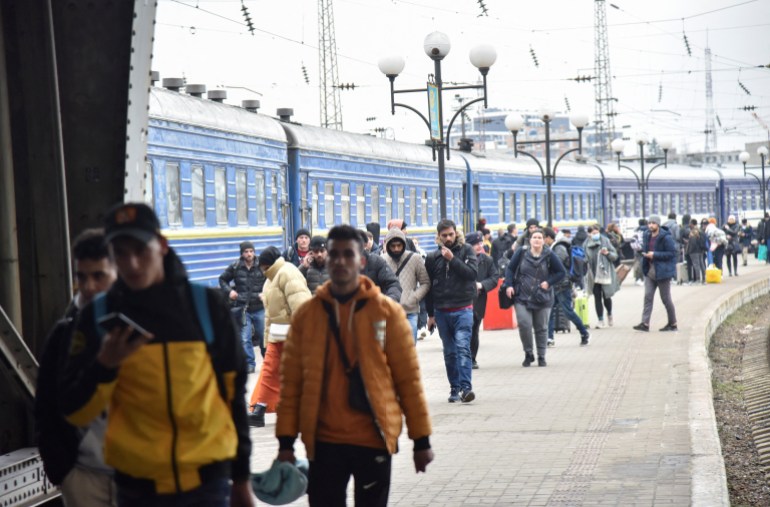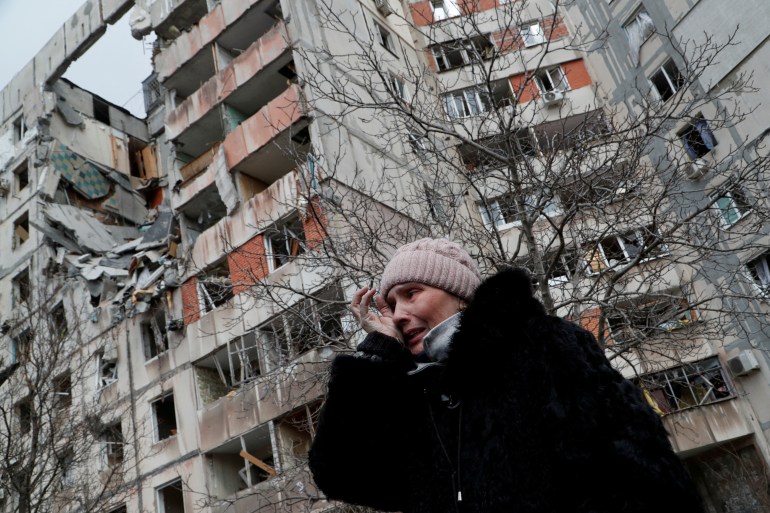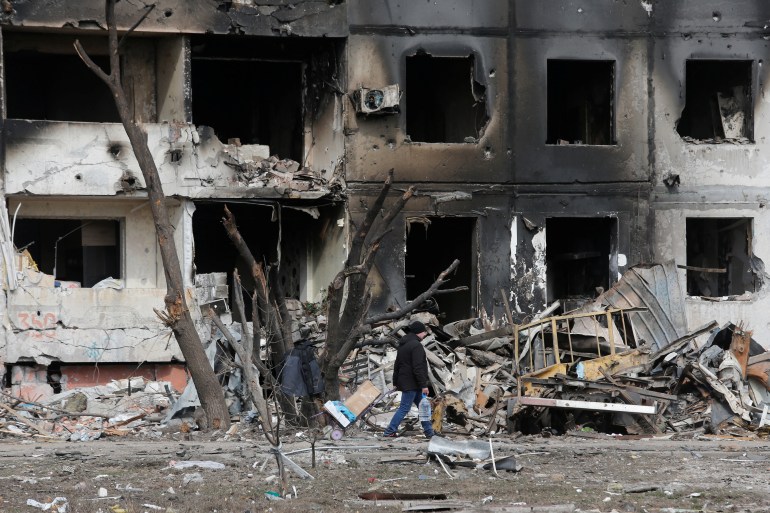Timeline: A month of Russian war in Ukraine | Russo-Ukrainian War
Russian President Vladimir Putin launched a full-scale invasion of Ukraine in the early hours of February 24, sparking the biggest war against a European state since World War II.
In the month since the invasion began, more than 10 million people have been displaced, several Ukrainian cities have been besieged and bombed beyond recognition, and hundreds of civilians have been killed.
Russia has been hit with severe punitive sanctions, including asset freezes and export bans. These clouded the growth outlook for the global economy, which had only just begun to recover from the COVID-19 recession.
The key moments of the first month of the war are as follows:
February 24: Russia launches full-scale assault on Ukraine. Ukrainian President Volodymyr Zelensky orders a general mobilization.
The Moscow stock market falls 45% after the United States announced sanctions against Russian banks.
February 26: The European Union excludes some Russian banks from the Society for Worldwide Interbank Financial Telecommunications (SWIFT), cutting them off from the global financial system.
February 27: The EU prohibits Russian civil aircraft from entering EU airspace. State media Sputnik and Russia Today (RT) and their affiliates are banned from EU airwaves and the internet.
Russian troops are moving towards the Ukrainian capital, kyiv, and towards Kharkiv and Kherson. Ukrainians enlist.
February 28: Ukraine is applying to join the EU. Russia and Ukraine begin ceasefire talks. The Russian ruble falls 30%, forcing Putin to impose capital controls. The EU bans transactions with the Russian central bank and approves a 500 million euro ($554 million) support plan for the Ukrainian army. This is the first time that the EU has agreed to supply lethal material to a third country.
1st of March: A 65 km Russian convoy is heading towards kyiv. Pressure is increasing on Kharkiv and Mariupol to the east, and Kherson to the south. Human Rights Watch reports that the Russians are using cluster bombs against civilians. The United States closes its skies to Russian planes.
March 2: Russian tanks enter Kherson, the first and only regional capital to fall in the first month of the war. Russian forces surround the port city of Mariupol in southeastern Ukraine. The number of refugees who have fled Ukraine exceeds one million.
3rd of March: The chief prosecutor of the International Criminal Court sends an advance team to investigate possible war crimes.
March 4: Putin blocks Twitter, Facebook, Voice of America, the BBC and Deutsche Welle – among other media platforms – in Russia. He signs a law criminalizing “fake news”, which could give offenders up to 15 years in prison.
March 5: US Secretary of State Antony Blinken meets his Ukrainian counterpart Dmytro Kuleba at the Polish-Ukrainian border.
The United States urges its citizens to leave Russia immediately.
Aeroflot, Russia’s largest state-owned airline, said it would halt all international flights.
March 7: Brent crude briefly hits a high of $139.13 a barrel.
Ukrainian refugees number 1.7 million.

8 March: Civilians are fleeing the city of Sumy via an evacuation corridor as agreed during talks between Moscow and Kyiv.
The United States rejects a Polish offer to transfer Soviet-era MiG-29 fighter jets to the Ukrainian Air Force as it seeks to keep NATO out of the war.
The European Commission unveils REPowerEU, a plan to reduce dependence on Russian natural gas by two-thirds by the end of the year.
The United States imposes a ban on imports of Russian crude oil, bringing to 30% the increase in oil prices since the Russian invasion.
The number of Ukrainian refugees exceeds two million.
March 9: Russian airstrikes hit a maternity hospital in Mariupol, killing three people. Russia claims the hospital housed “radicals”.
Streams of refugees flee the bloody battles in the northwestern suburbs of Kyiv, Irpin and Vorzel.
The Executive Board of the International Monetary Fund approves $1.4 billion in emergency financing for Ukraine.
March 10: Russian forces shell an evacuation corridor, preventing humanitarian supplies from reaching Mariupol.
US Congress approves $13.6 billion in spending for refugee and military aid.
March 11: Russians kidnap the mayor of Melitopol, a city in southeastern Ukraine.
Putin approves the deployment of up to 16,000 irregular fighters from Syria.
The total number of refugees exceeds 2.5 million and another 2 million people are internally displaced, according to the United Nations High Commissioner for Refugees.
The EU publishes the Versailles declaration, moving in the direction of a European defense capability.
12th of March: In Mariupol, a team of journalists from the Associated Press news agency films a Russian tank bombarding a building and an AP journalist is among the medical personnel targeted by Russian sniper fire. Russian forces loot a humanitarian convoy trying to relieve the townspeople.

March 13: Russia is expanding its attacks into western Ukraine, firing 30 cruise missiles at a military training base in Yavoriv, 25 km from the Polish border. At least 35 people are killed and 134 others injured, according to Ukrainian officials.
March 14: Chechen leader and Putin loyalist Ramzan Kadyrov says Chechens have joined Moscow’s fight against Ukraine.
US warns China it will not tolerate any form of sanctions relief on Russia, as US National Security Adviser Jake Sullivan meets with China’s Foreign Affairs Director Yang Jiechi to interviews.
Around 160 cars manage to leave Mariupol, as the Russians block an aid convoy bound for the town.
March 15: The Czech, Polish and Slovenian Prime Ministers take the train to kyiv.
Twenty thousand civilians manage to flee Mariupol. The number of refugees exceeds three million.
Zelenskyy told European officials he did not believe NATO membership was a prospect for Ukraine, pointing to possible grounds for compromise in negotiations with Moscow.
March 16: Russian and Ukrainian negotiators say they are discussing Ukraine’s neutrality in exchange for security guarantees and the departure of Russian troops.
Putin compares domestic war opponents to “midges” that weaken the country. He speaks of a “natural and necessary self-purification of society” which will “strengthen the country”, hinting at a potential repression of dissent.

March 18: Ukraine says it has rescued 130 people from the ruins of the Mariupol Municipal Theater, bombed two days earlier, and warns that hundreds more could be trapped under the rubble. Another 5,000 civilians are evacuated from the city, bringing the number of evacuees to 35,000. Russian forces enter the city and fighting is reported in the center, as Ukrainian officials say the city has lost access to the sea. The Mariupol City Council estimates that 2,500 people were killed in the Russian bombardment.
Six missiles are fired from the Black Sea at the western city of Lviv. Two are intercepted and four hit an aircraft repair hangar, killing one person.
US President Joe Biden is warning Chinese President Xi Jinping of the “consequences” if China offers Russia “material support” in the conflict.
March 20th: Russian airstrikes destroy an art school in Mariupol where some 400 civilians are said to have taken refuge.
The UN says more than 10 million people have been displaced in Ukraine, including those who have fled the country.
March 21st: Ukraine rejects Russian ultimatum to surrender to Mariupol.
March 22: Biden says Putin’s consistent assertions that Ukraine has chemical and biological weapons are a “clear sign that he is considering using both.”


Comments are closed.